AUDI S8 2010 Owners Manual
Manufacturer: AUDI, Model Year: 2010, Model line: S8, Model: AUDI S8 2010Pages: 384, PDF Size: 90.95 MB
Page 191 of 384

______________________________________________ D_ ri_v _ i_n _,,g ,c.._ S_a_ f_ e_ l..:: y __ _
& WARNING (continued)
• Always adjust the driver's seat and the steering wheel so that
there are at least 4 inches (10 cm) between the knees and the
lower part of the instrument panel.
• Always hold the steering wheel on the outside of the steering
wheel rim with your hands at the
9 o'clock and 3 o'clock positions
to help reduce the risk of personal injury if the driver's airbag inflates.
• Never hold the steering wheel at the
12 o'clock position or with
your hands at other positions inside the steering wheel rim or on
the steering wheel hub. Holding the steering wheel the wrong way can cause serious injuries to the hands, arms and head if the
driver's airbag inflates
• Pointing the steering wheel toward your face decreases the
ability of the supplemental driver's airbag to protect you in a colli
sion.
• Always sit in an upright position and never lean against or
place any part of your body too close to the area where the airbags
are located.
• Before driving, always adjust the front seats and head
restraints properly and make sure that all passengers are properly
restrained.
• Never adjust the seats while the vehicle is moving. Your seat
may move unexpectedly and you could lose control of the vehicle .
• Never drive with the backrest reclined or tilted far back! The
farther the backrests are tilted back, the greater the risk of injury
due to incorrect positioning of the safety belt and improper
seating position.
• Children must always ride
in child seats ::::;, page 231. Special
precautions apply when installing a child seat on the front
passenger seat ::::;,
page 206. •
Controls and equip
ment Safety first Vehicle operation
Proper seating position for the front
passenger
The
proper front passenger seating position is important
for safe, relaxed driving.
For your own safety and to reduce the risk of injury in the
event of an accident, we recommend that you adjust the seat
for the front passenger to the following position:
- Adjust the angle of the seatback so that it is in an upright
position and your back comes in full contact with it when
ever the vehicle is moving.
- Adjust the head restraint so that the upper edge is as even
with the top of your head as possible but not lower than
eye level and so that it is as close to the back of your head
as possible =>
page 191.
-Keep both feet flat on the floor in front of the front
passenger seat.
- Fasten and wear safety belts correctly=>
page 201.
For detailed information on how to adjust the front passenger's seat,
see::::;,
page 76 .
& WARNING
Front seat passengers who are unbelted, out of position or too
close to the airbag can be seriously injured or killed by the airbag
as it unfolds. To help reduce the risk of serious personal injury:
• Passengers must always sit in an upright position and never
lean against or place any part of their body too close to the area
where the airbags are located.
• Passengers who are unbelted, out of position or too close to
the airbag can be seriously injured by an airbag as it unfolds with
great force in the blink of an eye. ..
Vehicle care Do-it-yourself service Technical data
Page 192 of 384
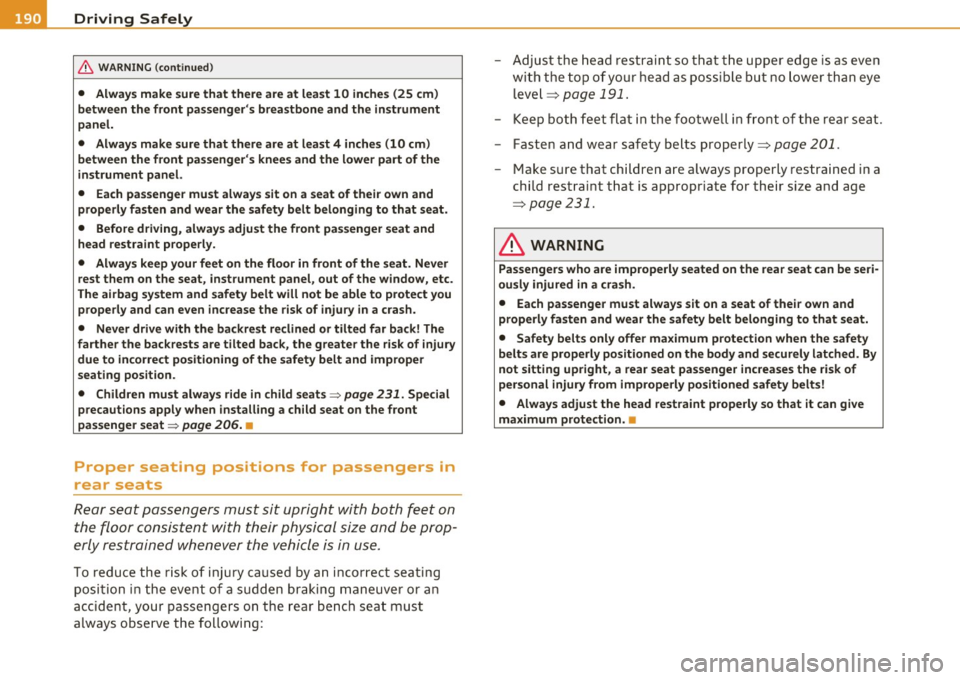
-Driving Safely -----~ ~'-----------------------------
& WARNING (continued)
• Always make sure that there are at least 10 inches (25 cm)
between the front passenger's breastbone and the instrument
panel.
• Always make sure that there are at least 4 inches (10 cm)
between the front passenger's knees and the lower part of the
instrument panel.
• Each passenger must always sit on a seat of their own and properly fasten and wear the safety belt belonging to that seat.
• Before driving, always adjust the front passenger seat and
head restraint properly.
• Always keep your feet on the floor in front of the seat. Never
rest them on the seat, instrument panel, out of the window, etc.
The airbag system and safety belt will not be able to protect you
properly and can even increase the risk of injury in a crash.
• Never drive with the backrest reclined or tilted far back! The
farther the backrests are tilted back, the greater the risk of injury due to incorrect positioning of the safety belt and improper
seating position.
• Children must always ride in child seats ~
page 231. Special
precautions apply when installing a child seat on the front
passenger seat~
page 206. •
Proper seating positions for passengers in
rear seats
Rear seat passengers must sit upright with both feet on
the floor consistent with their physical size and be prop
erly restrained whenever the vehicle is in use.
To reduce the risk of injury caused by an incorrect seating
position in the event of a sudden braking maneuver or an
accident, your passengers on the rear bench seat must
always observe the following : -
Adjust the head restraint so that the upper edge is as even
with the top of your head as possible but no lower than eye
level=>
page 191.
- Keep both feet flat in the footwell in front of the rear seat.
- Fasten and wear safety belts properly=>
page 201.
- Make sure that children are always properly restrained in a
child restraint that is appropriate for their size and age
=>
page 2 31.
& WARNING
Passengers who are improperly seated on the rear seat can be seri·
ously injured in a crash.
• Each passenger must always sit on a seat of their own and
properly fasten and wear the safety belt belonging to that seat.
• Safety belts only offer maximum protection when the safety
belts are properly positioned on the body and securely latched. By
not sitting upright, a rear seat passenger increases the risk of
personal injury from improperly positioned safety belts!
• Always adjust the head restraint properly so that it can give
maximum protection. •
Page 193 of 384

________________________________________________ D_ r_ i_ v _i_n _,,,g ~ S_a_ f_ e_ l _,,y'-- __
Proper adjustment of head restraints
Correctly adjusted head restraints are an important part
of your vehicle 's occupant restraint system and can help
to reduce the risk of injuries in accident situations .
Fig. 200 Correctly
adjusted head
restraint viewed from
the side
The head restra ints must be correctly adjusted to achieve the
best protection.
- Adjust the head restraint so that the upper edge of the
restraint is level with the top of your head, but no lower
than eye level and so it is as close to the back of your head
as possible ~ fig. 200.
Adjusting head restraints=> page 81.
& WARNING
Driving without head restraints or with improperly adjusted head
restraints increases the risk of serious injuries in a collision. To
help reduce the risk of injury:
• Always drive with the head restraints in place and properly
adjusted.
• Every person in the vehicle must have a properly adjusted head
restraint.
Controls and equip ment Safety first Vehicle operation
& WARNING (continued)
•
Always make sure each person in the vehicle properly adjusts
their head restraint. Each head restraint must be adjusted
according to occupants' size so that the upper edge is as even with
the top of the person's head, but no lower than eye level and so it
is as close to the back of to the head as possible.
• Never attempt to adjust head restraint while driving. If you
have driven off and must adjust the driver headrest for any reason,
first stop the vehicle safely before attempting to adjust the head
restraint.
• Children must always be properly restrained in a child restraint
that is appropriate for their age and size =>
page 231. •
Examples of improper seating positions
The occupant restraint system can only reduce the risk of
injury if vehicle occupants are properly seated.
Improper seat ing positions can cause serious injury or death.
Safety belts can only work when they are properly positioned
on the body . Improper seating positions reduce the effective
ness of safety belts and will even increase the risk of injury
and death by moving the safety belt to critical areas of the body. Improper seating positions also increase the risk of
serious injury and death when an airbag deploys and strikes
an occupant who is not in the proper seating position. A
driver is responsible for the safety of all vehicle occupants
and especially for children. Therefore:
- Never allow anyone to assume an incorrect seating posi
tion when the vehicle is being used~& .
The following bulletins list only some sample positions that will
i ncrease the risk of ser iou s injury and death . Our hope is that these .,_
Vehicle care Do-it-yourself service Technical data
Page 194 of 384
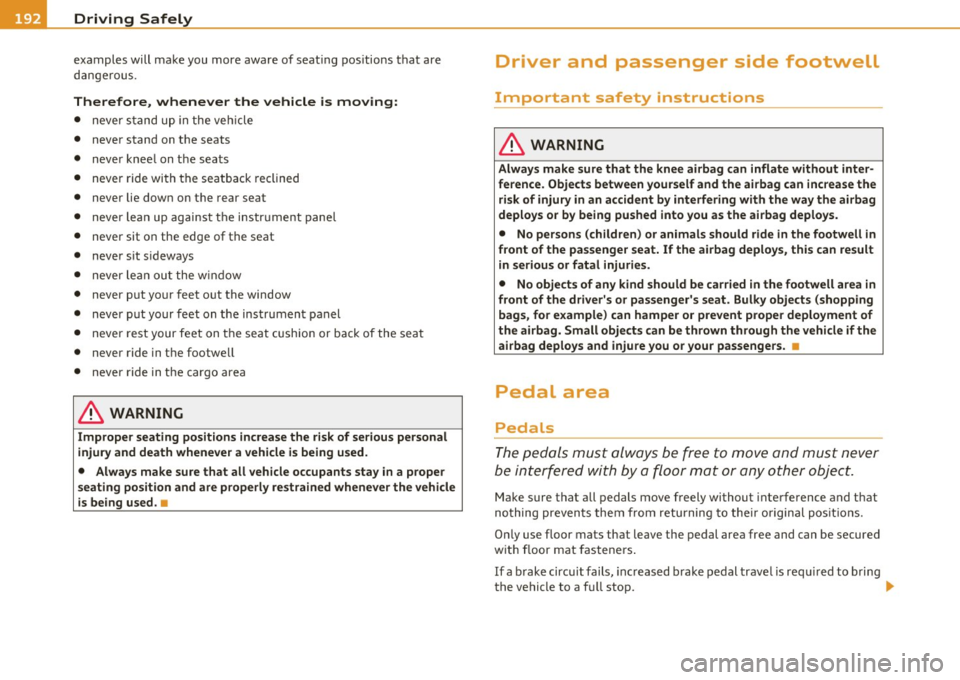
• ....__D_ r_iv _i_ n_, g=-- S_ a _ f_e _,Ly _ ______________________________________________ _
examples will make you more aware o f seat ing pos itions that are
d ang erou s.
Therefore, whenever the vehicle is moving:
• never s tand u p in the ve hicle
• never stand on the seats
• nev er knee l on the seats
• never ride with t he se atb ack reclined
• never lie dow n on the rear seat
• neve r lean up agains t th e i nstr ument pane l
• never sit on the edge of the seat
• never sit s ideways
• never le an out the w indow
• never p ut your feet o ut the window
• never p ut your fe e t on th e ins trumen t panel
• never rest your feet on t he se at cushio n or back of the se at
• never ride in t he footwell
• neve r ride in t he cargo area
& WARNING
Improper seating positions increase the risk of serious personal
injury and death whenever a vehicle is being used.
• Always make sure that all veh icle occupants stay
in a proper
seating position and are properly re strained whenever the vehicle
is being used. •
Driver and passenger side footwell
Important safety instructions
& WARNING
Always make sure that the knee airbag can inflate without inter
ference. Objects between yourself and the airbag can increase the
risk of injury in an accident by interfering w ith the way the airbag
deploys or by being pushed into you as the airbag deploys .
• No persons (children) or animals should ride in the footwell in
front of the passenger seat. If the airbag deploys, this can result in serious or fatal injuries.
• No objects of any kind should be carried in the footwell area in
front of the driver's or passenger's seat. Bulky objects (shopping
bags, for example) can hamper or prevent proper deployment of
the airbag. Small objects can be thrown through the vehicle if the
airbag deploys and injure you or your passengers. •
Pedal area
Pedals
The peda ls must a lway s be free to move an d must n ever
be interfered with by a floor mat or a ny othe r o bj e ct.
M ake sure that all pedals move freely without interference and that
no thing preven ts them from re tu rning to the ir original pos it io ns.
On ly use floor mats that leave the pedal area free and can be secured
w ith floor mat fas tene rs .
If a brake circu it fails, inc reas ed b rak e pedal trav el is req uired to b rin g
the vehicle to a f ull stop. ...
Page 195 of 384

------------------------------------------------=D __ r __ i..: v ....:..i.:...n :.::g ~ S:...:a=- f=-- e= ly~ _-
& WARNING
Pedals that cannot move freely can cause loss of vehicle control
and in crease the risk of serious injury .
• Never place any objects in the driver 's footwell. An object could
get into the pedal area and interfer e with peda l function . In ca se
of sudden braking or an accident, you would not be able to brake
or accelerate!
• Always make su re that noth ing can fall o r move into the
driver' s footwe ll. •
Floor mats on the driver side
Always use floor mats that can b e securely attach ed to
the floor mat fasteners and do not interfere with the fre e
movement of the pe dals.
- Make sure that the floor mats are properly secur ed and
cannot move and i nte rfere with t he peda ls=> &.
Use on ly floor ma ts t hat leave the pe dal area uno bstr ucted and that
are firm ly sec ured so that they cannot slip out of position . You can
obtain s uita ble f loor mats from yo ur authori zed Audi Dealer .
Floo r mat fas teners are installed in your Audi.
Floor mats used in your vehicle must be attached to these fasteners.
P roperly secur ing t he f loor mats wi ll prevent them from s lid ing into
positions that cou ld interfere with the peda ls or impa ir safe opera
ti on of your veh icle in other ways.
& WARNING
Pedals that cannot move freely can re sult in a loss of vehicle
control and inc rease the risk of serious personal injury.
• Alway s make sure that floor mats are properly se cured .
Controls and equip ment Safety first Vehicle operation
& WARNING
(co ntinued )
• Never place or in stall floo r m ats or other floor coverings in the
vehicle that cannot be properly secured in place to prevent them from slipping and interfering with the pedals or the ability to
c ontrol the v ehicle.
• Never place or install floor mat s or other floor coverings on top
of alr eady in stalled floor mats. Additional floor mat s and other
cove rings will reduce the size of the pedal area and interfere w ith
the pedals .
• Always properly rein stall and secure floor mats that have been
taken out for cleaning.
• Always make sure that objects cannot fall into the driver foot
well while the vehicle is moving . Obje cts can become trapped
under the brake pedal and accele rator pedal causing a loss of
vehicle control. •
Stowing luggage
Loading the luggage compartment
All luggage and oth er objects must be properly stowed
and secured in the lu ggage comp artment.
Loose items in t he luggage compartme nt can s hift suddenly ,
chang ing ve hicle handling c haracteristics. Loose items ca n
also incre ase the r isk of serious pe rsonal i njury in a sudde n
veh icle maneuver or in a co llis io n.
- Distr ibute the loa d eve nly in t he luggage compartme nt.
- Always pla ce and p roperl y se cure heavy it em s in the
l u gg age compar tme nt a s far forwar d as possi ble .
- S ecur e luggag e using t he tie -d ow ns prov id ed =>
page 90,
"Lugga ge com partm ent". 1111-
Vehicle care Do-it-yourself service Technical data
Page 196 of 384
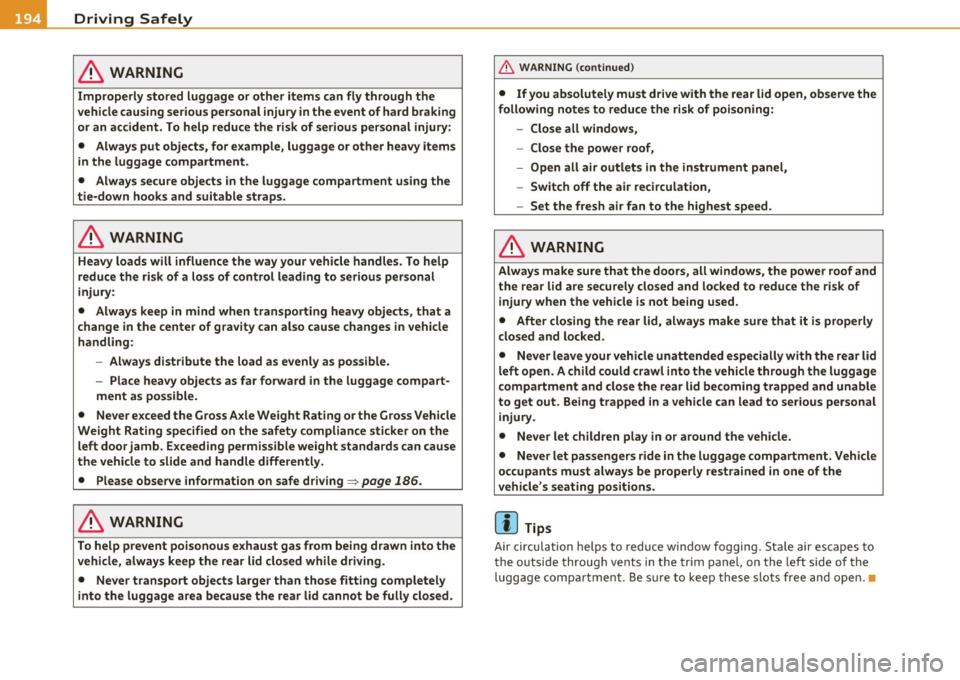
111....__D_ r_iv _i_ n_, g=-- S_ a _ f_e _,Ly _ ______________________________________________ _
in. WARNING
Improperly stored luggage or other items can fly through the
vehicle causing serious personal injury in the event of hard braking
or an accident. To help reduce the risk of serious personal injury:
• Always put objects, for example, luggage or other heavy items
in the luggage compartment.
• Always secure objects in the luggage compartment using the
tie-down hooks and suitable straps.
& WARNING
Heavy loads will influence the way your vehicle handles. To help
reduce the risk of a loss of control leading to serious personal
injury:
• Always keep in mind when transporting heavy objects, that a
change in the center of gravity can also cause changes in vehicle
handling:
-Always distribute the load as evenly as possible.
- Place heavy objects as far forward in the luggage compart-
ment as possible.
• Never exceed the Gross Axle Weight Rating or the Gross Vehicle
Weight Rating specified on the safety compliance sticker on the
left door jamb. Exceeding permissible weight standards can cause
the vehicle to slide and handle differently.
• Please observe information on safe driving
=> page 186.
in. WARNING
To help prevent poisonous exhaust gas from being drawn into the
vehicle, always keep the rear lid closed while driving.
• Never transport objects larger than those fitting completely
into the luggage area because the rear lid cannot be fully closed.
& WARNING (continued)
• If you absolutely must drive with the rear lid open, observe the
following notes to reduce the risk of poisoning:
-Close all windows,
- Close the power roof,
- Open all air outlets in the instrument panel,
- Switch off the air recirculation,
- Set the fresh air fan to the highest speed.
in. WARNING
Always make sure that the doors, all windows, the power roof and
the rear lid are securely closed and locked to reduce the risk of
injury when the vehicle is not being used.
• After closing the rear lid, always make sure that it is properly
closed and locked.
• Never leave your vehicle unattended especially with the rear lid
left open. A child could crawl into the vehicle through the luggage
compartment and close the rear lid becoming trapped and unable
to get out. Being trapped in a vehicle can lead to serious personal
injury.
• Never let children play in or around the vehicle.
• Never let passengers ride in the luggage compartment. Vehicle
occupants must always be properly restrained in one of the
vehicle's seating positions.
(I) Tips
Air circulation helps to reduce window fogging. Stale air escapes to
the outside through vents in the trim panel, on the left side of the
luggage compartment . Be sure to keep these slots free and open.•
Page 197 of 384

____________________________________________ D_ r_ iv _ in_ g,,,.,_ S_ a_ fe___,, ly'--- __
Tie-downs
The luggage compartment is equipped with four tie
downs to secure luggage and other items.
Use the t ie-downs to secure yo ur cargo properly ~ page 193,
"Loading the luggage compartment".
In a collision, the laws of physics mean that even sma ller items that
are loose in the vehicle will become heavy missiles t hat can cause
serious injury. Items in the vehicle possess energy wh ich vary w ith
vehicle speed and the weight of the item. Vehicle speed is the most
significant factor.
For examp le, in a frontal coll is ion at a speed of 30 mph (48 km/h),
the forces acting on a 10-lb (4 .5 kg) object a re ab out 20 times the
normal weig ht of the item. This means that the weight of the item
wou ld s uddenly be abo ut 20 0 lbs. (90 kg). You can imagine the inju
r ies that a 200 lbs. (90 kg) item flying freely throug h the passenger
compartment could cause in a collision like this .
& WARNING
Weak, damag ed or improper straps us ed to secure item s to tie
downs can fail dur ing hard braking or in a collision and cause
s eriou s personal injury.
• Always u se suitable mounting straps and prope rly se cure items
to the tie -downs in the luggage compartment to help prevent
items from shifting or flying forward as dangerous missiles. •
Reporting Safety Defects
Applicable to U.S.A.
If you belie ve that your vehicle has a defect
which could cause a crash or coul d cause injury
or death, you should immedi ate ly inform the
Controls and equip
ment Safety first Vehicle operation
National Highway Traffic S
afet y Admini stration
(NHTSA) in addition to notifying Audi of
America, Inc.
If NHTSA re ce ive s similar complaints, it may
op en a n inve stig ation , and if it finds that a
safety defects exists in a group of vehicles, it
may order a recall and remedy campaign.
However, NHTSA cannot become involved in
indi vidual problem s between y ou, y our dealer,
or Audi of Am erica, Inc.
To contact NHTSA, you may call the Vehicle Safety Hotline toll-free at:
Tel.: 1 -888-32 7-4236 (TTY: 1-800-424 -9153)
or write to:
Admini strator
NHTSA 1200 New Jer sey A venue, SE
Washington, D.C . 20590
You can also obtain other information about motor vehi cle safety from :
http: / /www .safer car.gov
Applicable to Canada
Canadian customer s who wish to report a
safety-related defect to Tr ansport Canada,
Vehicle care Do-it-yourself service Technical data
Page 198 of 384
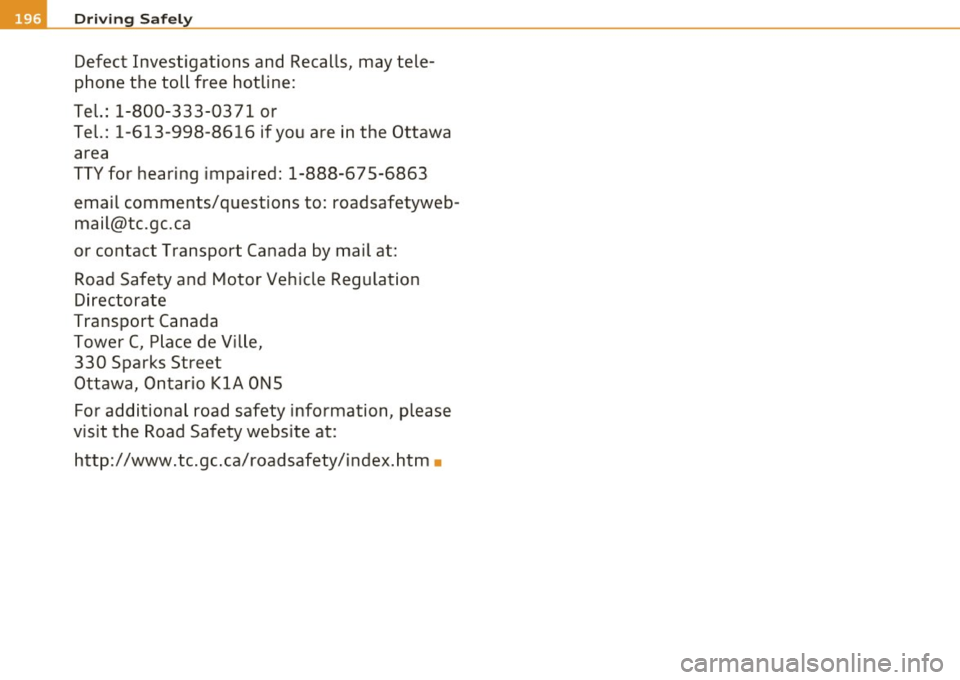
ffl Driving Safely
Defect Investigations and Recalls, may tele
phone the toll free hotline:
Tel.: 1-800-333-0371 or
Tel.: 1-613-998-8616 if you are in the Ottawa
area
TTY for hearing impaired: 1-888-675-6863
email comments/questions to: roadsafetyweb[email protected]
or contact Transport Canada by mail at:
Road Safety and Motor Vehicle Regulation Directorate
Transport Canada
Tower C, Place de Ville, 330 Sparks Street
Ottawa, Ontario
KlA ONS
For additional road safety information, please
visit the Road Safety website at:
http:/ /www.tc.gc.ca/roadsafety/index.htm •
Page 199 of 384

_____________________________________________ S_a _f _e _t _y _b_ e_lt _ s __ l!'II
Safety belts
General notes
Always wear safety belts!
Wearing safety belts correctly saves lives!
This chapter explains why safety belts are necessary, how
they work and how to adjust and wear them correctly.
- Read all the information that follows and heed all of the
instructions and WARNINGS.
& WARNING
Not wearing safety belts or wearing them improperly increases
the risk of serious personal injury and death.
• Safety belts are the single most effective means available to
reduce the risk of serious injury and death in automobile acci
dents. For your protection and that of your passengers, always
correctly wear safety belts when the vehicle is moving.
• Pregnant women, injured, or physically impaired persons must
also use safety belts. Like all vehicle occupants, they are more
likely to be seriously injured if they do not wear safety belts. The
best way to protect a fetus is to protect the mother - throughout
the entire pregnancy. •
Number of seats
Your Audi has a total of five seating positions: two in the front and
three in the rear . Vehicles with power individual rear seats* have
seating for four: two in the front and two in the rear. Each seating
position has a safety belt.
Controls and equip
ment Safety first Vehicle operation
& WARNING
Not wearing
safety belts or wearing them improperly increases
the risk of serious personal injury and death.
• Never strap more than one person, including small children,
into any belt. It is especially dangerous to place a safety belt over
a child sitting on your lap.
• Never let more people ride in the vehicle than there are safety
belts available.
• Be sure everyone riding in the vehicle is properly restrained
with a separate safety belt or child restraint. •
Safety belt warning light t
Your vehicle has a warning system for the driver and front
seat passenger to remind you about the importance of
buckling-up.
Before driving off, always:
Fig. 201 Safety belt
warning light in the
instrument cluster -
enlarged
- Fasten your safety belt and make sure you are wearing it
properly .
IJ,,
Vehicle care Do-it-yourself service Technical data
Page 200 of 384
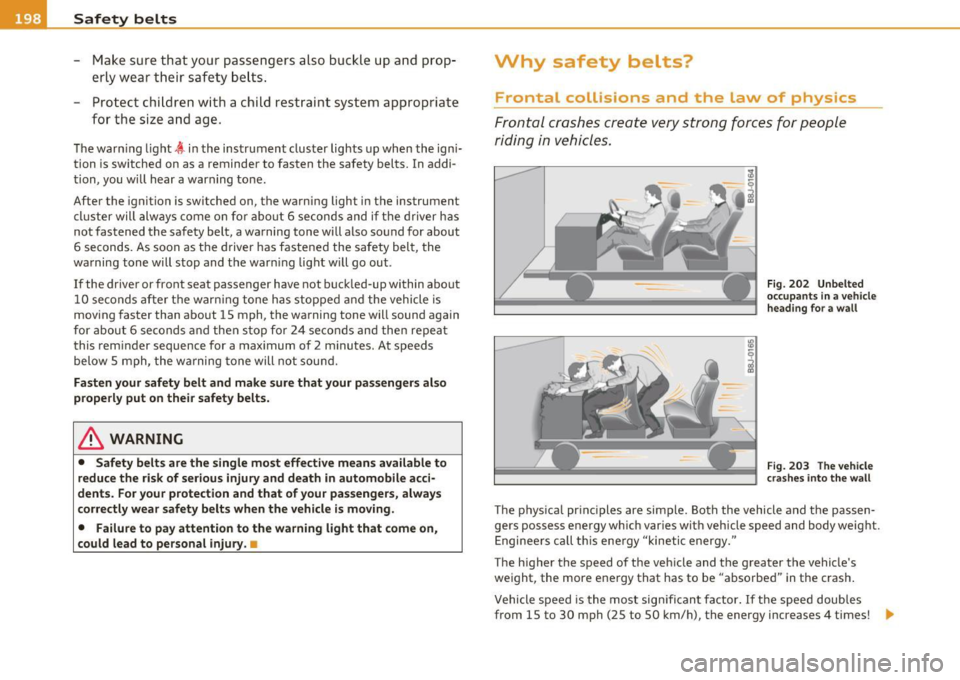
___ S_a _f_e _t-=y '-- b_e_ l_ t _s _____________________________________________ _
-Make sure that your passengers also buckle up a nd prop
erly wear their safety belts .
- Protect c hildren with a child rest raint system appropria te
fo r the size and ag e.
The warn ing light ~ in the instrument cluster lights up when the igni
tion is sw itched on as a reminder to fasten the safety belts. In addi
tion, you will hear a warn ing to ne .
After the ignition is switched on, the warn ing light in the instrument
clu ster will alw ays come on fo r a bout 6 seconds and i f the driver has
not fastened the safety belt, a warning tone will also sound for about
6 seconds. As soon as the d rive r has fastened the safety belt, the
warning tone will stop and the war ning light w ill go out.
If the driver or front seat passenger have not buck led-up within about
1 0 se conds afte r th e war ning tone has stopped and the veh icle is
moving faster than about 15 mph, the warning tone will sound again
for a bout 6 se conds and then s to p for 24 seco nds and the n re pea t
this rem inder sequence for a max imum of 2 m inutes . At speeds
below 5 mph, the w arning tone will not sou nd.
Fa sten your safety belt and make sure that your passenger s also
properly put on their safety belts.
& WARNING
• Safety belt s are the single most effe ctiv e mean s available to
reduce the risk of serious injury and death in automobile a cci
dents . For your protection and that of your pa ssenger s, always
c orrectly wear safety belts when the vehicle is moving .
• Failure to pay attention to the warning light that come on,
could lead to person al injury .•
Why safety belts?
Frontal collisions and the law of physics
Frontal cr ashes cre ate very stron g forc es for people
riding i n vehi cles.
Fig . 202 Unbe lted
o ccupa nts in a vehicle
h eading f or a w all
Fig. 203 Th e vehicle
cr as hes int o t he wall
The p hys ica l pr inc iples are simple. Both the vehicle and the passen
gers possess energy which var ies wit h veh icle speed and body weight.
E nginee rs ca ll t his ene rgy "kinetic energy."
The higher the speed of the veh icle and t he greater the vehicle's
we ight, the more energy that has to be "abso rbed" in the crash .
Vehicle speed is the most sig nifican t fa ctor. If t he speed doubles
from 15 to 30 mph (25 to 50 km/h), the energy increases 4 times! .,